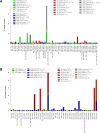Characterization of Genomic Variants Associated with Resistance to Bedaquiline and Delamanid in Naive Mycobacterium tuberculosis Clinical Strains
- PMID: 32907992
- PMCID: PMC7587096
- DOI: 10.1128/JCM.01304-20
Characterization of Genomic Variants Associated with Resistance to Bedaquiline and Delamanid in Naive Mycobacterium tuberculosis Clinical Strains
Abstract
The role of mutations in genes associated with phenotypic resistance to bedaquiline (BDQ) and delamanid (DLM) in Mycobacterium tuberculosis complex (MTBc) strains is poorly characterized. A clear understanding of the genetic variants' role is crucial to guide the development of molecular-based drug susceptibility testing (DST). In this work, we analyzed all mutations in candidate genomic regions associated with BDQ- and DLM-resistant phenotypes using a whole-genome sequencing (WGS) data set from a collection of 4,795 MTBc clinical isolates from six countries with a high burden of tuberculosis (TB). From WGS analysis, we identified 61 and 163 unique mutations in genomic regions potentially involved in BDQ- and DLM-resistant phenotypes, respectively. Importantly, all strains were isolated from patients who likely have never been exposed to these medicines. To characterize the role of mutations, we calculated the free energy variation upon mutations in the available protein structures of Ddn (DLM), Fgd1 (DLM), and Rv0678 (BDQ) and performed MIC assays on a subset of MTBc strains carrying mutations to assess their phenotypic effect. The combination of structural and phenotypic data allowed for cataloguing the mutations clearly associated with resistance to BDQ (n = 4) and DLM (n = 35), only two of which were previously described, as well as about a hundred genetic variants without any correlation with resistance. Significantly, these results show that both BDQ and DLM resistance-related mutations are diverse and distributed across the entire region of each gene target, which is of critical importance for the development of comprehensive molecular diagnostic tools.
Keywords: Mycobacterium tuberculosis; bedaquiline; delamanid; resistance to new drugs; whole-genome sequencing.
Copyright © 2020 American Society for Microbiology.
Figures






Similar articles
-
A Narrative Review of Bedaquiline and Delamanid: New Arsenals Against Multidrug-Resistant and Extensively Drug-Resistant Mycobacterium tuberculosis.J Clin Lab Anal. 2024 Aug;38(15-16):e25091. doi: 10.1002/jcla.25091. J Clin Lab Anal. 2024. PMID: 39431709 Free PMC article. Review.
-
Genetic diversity of candidate loci linked to Mycobacterium tuberculosis resistance to bedaquiline, delamanid and pretomanid.Sci Rep. 2021 Sep 30;11(1):19431. doi: 10.1038/s41598-021-98862-4. Sci Rep. 2021. PMID: 34593898 Free PMC article.
-
Multidrug Resistant Tuberculosis With Simultaneously Acquired Drug Resistance to Bedaquiline and Delamanid.Clin Infect Dis. 2021 Dec 16;73(12):2329-2331. doi: 10.1093/cid/ciaa1064. Clin Infect Dis. 2021. PMID: 32730621
-
Delamanid and bedaquiline resistance patterns in Mycobacterium tuberculosis in Iran: A cross-sectional analysis.New Microbes New Infect. 2024 May 26;60-61:101437. doi: 10.1016/j.nmni.2024.101437. eCollection 2024 Aug-Oct. New Microbes New Infect. 2024. PMID: 38873345 Free PMC article.
-
Whole Genome Sequencing for the Analysis of Drug Resistant Strains of Mycobacterium tuberculosis: A Systematic Review for Bedaquiline and Delamanid.Antibiotics (Basel). 2020 Mar 23;9(3):133. doi: 10.3390/antibiotics9030133. Antibiotics (Basel). 2020. PMID: 32209979 Free PMC article. Review.
Cited by
-
MycoVarP: Mycobacterium Variant and Drug Resistance Prediction Pipeline for Whole-Genome Sequence Data Analysis.Front Bioinform. 2022 Jun 3;1:805338. doi: 10.3389/fbinf.2021.805338. eCollection 2021. Front Bioinform. 2022. PMID: 36303799 Free PMC article.
-
Comparative Efficacy of the Novel Diarylquinoline TBAJ-587 and Bedaquiline against a Resistant Rv0678 Mutant in a Mouse Model of Tuberculosis.Antimicrob Agents Chemother. 2021 Mar 18;65(4):e02418-20. doi: 10.1128/AAC.02418-20. Print 2021 Mar 18. Antimicrob Agents Chemother. 2021. PMID: 33526488 Free PMC article.
-
High clustering rate and genotypic drug-susceptibility screening for the newly recommended anti-tuberculosis drugs among global extensively drug-resistant Mycobacterium tuberculosis isolates.Emerg Microbes Infect. 2022 Dec;11(1):1857-1866. doi: 10.1080/22221751.2022.2099304. Emerg Microbes Infect. 2022. PMID: 35792049 Free PMC article.
-
Comparative Efficacy of the Novel Diarylquinoline TBAJ-876 and Bedaquiline against a Resistant Rv0678 Mutant in a Mouse Model of Tuberculosis.Antimicrob Agents Chemother. 2021 Nov 17;65(12):e0141221. doi: 10.1128/AAC.01412-21. Epub 2021 Sep 27. Antimicrob Agents Chemother. 2021. PMID: 34570644 Free PMC article.
-
Multi-platform whole genome sequencing for tuberculosis clinical and surveillance applications.Sci Rep. 2024 Mar 3;14(1):5201. doi: 10.1038/s41598-024-55865-1. Sci Rep. 2024. PMID: 38431684 Free PMC article.
References
-
- WHO. 2019. Global tuberculosis report, 2019. WHO, Geneva, Switzerland: https://www.who.int/tb/publications/global_report/en/.
-
- WHO. 2019. Consolidated guidelines on drug-resistant tuberculosis treatment. WHO, Geneva, Switzerland: https://www.who.int/tb/publications/2019/consolidated-guidelines-drug-re....
-
- Bloemberg GV, Keller PM, Stucki D, Trauner A, Borrell S, Latshang T, Coscolla M, Rothe T, Hömke R, Ritter C, Feldmann J, Schulthess B, Gagneux S, Böttger EC. 2015. Acquired resistance to bedaquiline and delamanid in therapy for tuberculosis. N Engl J Med 373:1986–1988. doi:10.1056/NEJMc1505196. - DOI - PMC - PubMed
-
- Hoffmann H, Kohl T, Hofmann-Thiel S, Merker M, Beckert P, Jaton K, Nedialkova L, Sahalchyk E, Rothe T, Keller PM, Niemann S. 2016. Delamanid and bedaquiline resistance in Mycobacterium tuberculosis ancestral Beijing genotype causing extensively drug-resistant tuberculosis in a Tibetan refugee. Am J Respir Crit Care Med 193:337–340. doi:10.1164/rccm.201502-0372LE. - DOI - PubMed
-
- Ghodousi A, Rizvi AH, Baloch AQ, Ghafoor A, Khanzada FM, Qadir M, Borroni E, Trovato A, Tahseen S, Cirillo DM. 2019. Acquisition of cross-resistance to bedaquiline and clofazimine following treatment for tuberculosis in Pakistan. Antimicrob Agents Chemother 63:e00915-19. doi:10.1128/AAC.00915-19. - DOI - PMC - PubMed
MeSH terms
Substances
Grants and funding
LinkOut - more resources
Full Text Sources
Molecular Biology Databases

